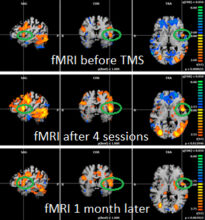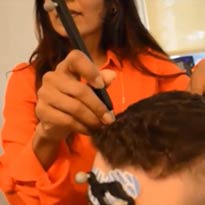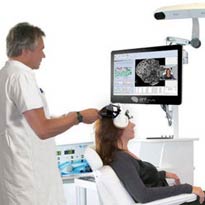
What is brain stimulation or neuromodulation?
Brain stimulation using Brain Exercises (BE) and Transcranial Magnetic Stimulation (TMS) helps the brain recover from injury and maintain function. Failing neural networks are preferentially stimulated to hasten recovery. This strengthens and repairs the brain’s connectome, key for optimizing brain function. Park Avenue Neurology offers TMS paired with evidence-based neurorehabilitation to help treat neurological conditions. Other places offering such treatment include Johns Hopkins and Harvard
 Dr. Devi discusses the role of TMS in treating dementia and Alzheimer’s on Medscape/ WebMD.
Dr. Devi discusses the role of TMS in treating dementia and Alzheimer’s on Medscape/ WebMD. Brain stimulation improved short term memory loss in one study of older adults.
Brain stimulation improved short term memory loss in one study of older adults.
What does brain stimulation do to your brain?
Both TMS and BE increase blood flow to target areas and help strengthen neural connections. This functional MRI slide shows increased flow in the region of interest (circled) after TMS, maintained a month later, in a patient with Alzheimer’s disease. Dr. Devi has been working on TMS and cognition since 2008 and has presented her work at the annual meetings of the European Academy of Neurology and the American Academy of Neurology.
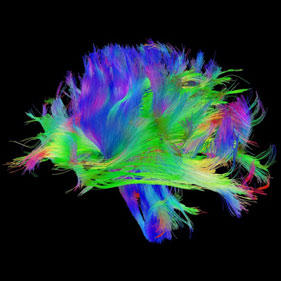
An actual 3D image of the brain’s connectome. It is highly individual, molded by strengths, deficits, & experiences and constantly changing, and forms the basis of neuroplasticity. TMS, FDA approved for treating depression, OCD, and migraines, is used “off-label” for treating other neurological conditions. It works by modifying the brain’s connectome.

What neurologic conditions may brain stimulation be helpful in? Conditions that may be helped by harnessing the brain’s neuroplasticity will be helped by brain stimulation.
Both TMS and BE may aid recovery from:
Stroke
Brain Injury
Cognitive disorders (Alzheimer’s, dementia)
Language and communication disorders (aphasia)
Weakness (hemiparesis)
Chronic pain, neuropathy, migraines

There are several ways to stimulate the brain externally. We may use one or both of the following, based on the results of your evaluation, transcranial magnetic stimulation (TMS) and brain exercises. TMS uses a magnetic field to stimulate parts of the brain. As the coil is placed over your head, you will hear a click and may feel a pulling sensation on the skin under the coil. Often patients describe the feeling as a tapping sensation on the head. Brain exercises uses one-on-one treatment with a specialist, targeting impaired areas.

How do you know where to stimulate?
In TMS, the patient’s MRI is used along with neurocognitive tests to guide the area to stimulate. In BE, the patient’s neurocognitive tests are used to guide the area to stimulate.
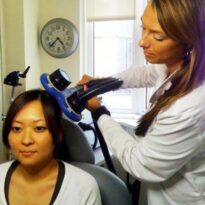
How long does each TMS or BE last? How long is a course of treatment? Regardless of the approach (but depending on the condition), brain stimulation typically works best when paired with rehabilitation. While most applications of TMS last about 30 minutes, the treatment is often combined with physical therapy or brain exercises, based on the underlying condition. A typical treatment course aims to deliver high-intensity rehabilitation training in at least 20 sessions spaced over months, once to twice a week.
Brain exercises last about 50 minutes. TMS helps boost the effects of the rehabilitation.

